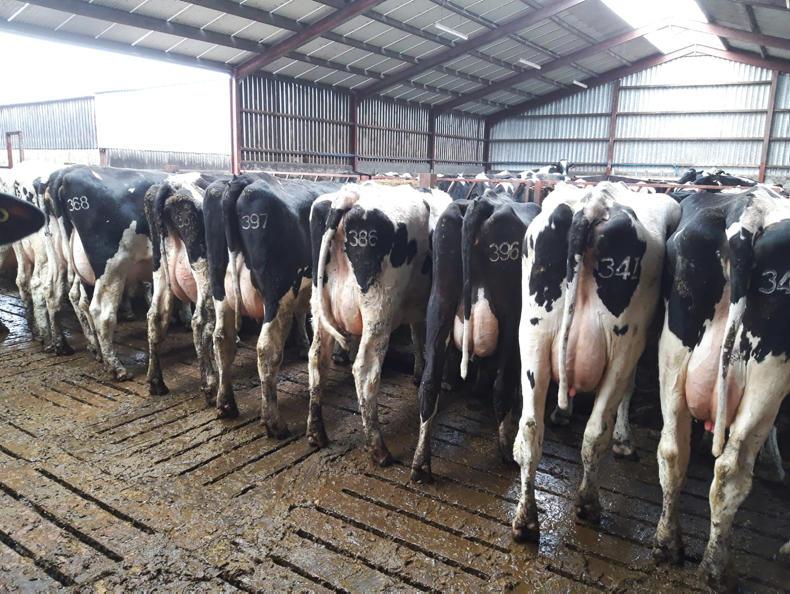I have taken advantage of improved ground conditions in recent weeks and have contractors in to undertake draining, fencing, ploughing and making ground ready for wholecrop.
My role in it all seems to be lifting stones and standing in the middle of it all trying not to be in the way. It’s great sometimes to be able to stand back and watch work going on all around, if only I could do so without mentally adding up the bill every time another load of stones comes up the lane.
One of the fields earmarked for wholecrop this year has gradually gotten wetter at the bottom over the last number of years
In recent times I have gotten into the habit of growing crop in a field for two years before going back into grass. Therefore, before ploughing, it is an opportune time to carry out any remedial drainage work.
One of the fields earmarked for wholecrop this year has gradually gotten wetter at the bottom over the last number of years. More recently, this wet area has gradually crept up the field.
After digging a few holes to find old existing drains to tap into, the contractor thought that springs could be the cause of the problem.
The next stage was to dig out the springs, fill them up with stones and then run a catch drain along the length of the field taking the water to old existing drains
With this in mind, we got someone in to divine for springs. He walked the length of the field and found 11 springs, all within 15ft from the hedge.
The next stage was to dig out the springs, fill them up with stones and then run a catch drain along the length of the field taking the water to old existing drains. Luckily, most of the springs were only down seven or eight feet. By the end of this week, this field will be ploughed and planted with rye for wholecrop. When compared with last year, it has been a pleasure to be out working in the fields.
Grass
At this stage, the low-yielding group is out at grass all day. I haven’t had a chance to plate-meter the paddocks, but I estimate opening covers are around 2,700kg of dry matter per hectare (DM/ha).
With excellent ground conditions and little rain, cleanout is good and I would estimate residuals to be around 1,800 DM/ha to 1900kg DM/ha. As ever with a high-yielding herd, there is a fine balance between grass utilisation and maximising production. One concern would be that the cold, biting wind we have had has hurt regrowth, but that should quickly change with the warmer weather this week.
Production
Despite struggling with production earlier in winter, cows have continued to milk well since we got their diet ironed out.
First-cut silage has also been removed from the diet, and 8kg of wholecrop has been introduced
Production currently stands at 33.5l/cow, at 4.19% butterfat and 3.3% protein. SCC is 127 and TBC is four. The feed rate is good, at 0.36kg/l.
With the low group out and getting good intakes of grass, I have taken 1.5kg of blend out of their TMR.
First-cut silage has also been removed from the diet, and 8kg of wholecrop has been introduced.
With milk price under pressure (needlessly in my opinion), costs will have to be closely monitored, while at the same time maximising production to keep the milk cheque up.
Unfortunately, price cuts are coming at a time when bills tend to come thick and fast. On this farm, we are now entering the most difficult time of year in terms of cashflow.
Read more
Higher feed protein solves milk yield puzzle
Farmer Writes: top heifers don’t always make the best cows
I have taken advantage of improved ground conditions in recent weeks and have contractors in to undertake draining, fencing, ploughing and making ground ready for wholecrop.
My role in it all seems to be lifting stones and standing in the middle of it all trying not to be in the way. It’s great sometimes to be able to stand back and watch work going on all around, if only I could do so without mentally adding up the bill every time another load of stones comes up the lane.
One of the fields earmarked for wholecrop this year has gradually gotten wetter at the bottom over the last number of years
In recent times I have gotten into the habit of growing crop in a field for two years before going back into grass. Therefore, before ploughing, it is an opportune time to carry out any remedial drainage work.
One of the fields earmarked for wholecrop this year has gradually gotten wetter at the bottom over the last number of years. More recently, this wet area has gradually crept up the field.
After digging a few holes to find old existing drains to tap into, the contractor thought that springs could be the cause of the problem.
The next stage was to dig out the springs, fill them up with stones and then run a catch drain along the length of the field taking the water to old existing drains
With this in mind, we got someone in to divine for springs. He walked the length of the field and found 11 springs, all within 15ft from the hedge.
The next stage was to dig out the springs, fill them up with stones and then run a catch drain along the length of the field taking the water to old existing drains. Luckily, most of the springs were only down seven or eight feet. By the end of this week, this field will be ploughed and planted with rye for wholecrop. When compared with last year, it has been a pleasure to be out working in the fields.
Grass
At this stage, the low-yielding group is out at grass all day. I haven’t had a chance to plate-meter the paddocks, but I estimate opening covers are around 2,700kg of dry matter per hectare (DM/ha).
With excellent ground conditions and little rain, cleanout is good and I would estimate residuals to be around 1,800 DM/ha to 1900kg DM/ha. As ever with a high-yielding herd, there is a fine balance between grass utilisation and maximising production. One concern would be that the cold, biting wind we have had has hurt regrowth, but that should quickly change with the warmer weather this week.
Production
Despite struggling with production earlier in winter, cows have continued to milk well since we got their diet ironed out.
First-cut silage has also been removed from the diet, and 8kg of wholecrop has been introduced
Production currently stands at 33.5l/cow, at 4.19% butterfat and 3.3% protein. SCC is 127 and TBC is four. The feed rate is good, at 0.36kg/l.
With the low group out and getting good intakes of grass, I have taken 1.5kg of blend out of their TMR.
First-cut silage has also been removed from the diet, and 8kg of wholecrop has been introduced.
With milk price under pressure (needlessly in my opinion), costs will have to be closely monitored, while at the same time maximising production to keep the milk cheque up.
Unfortunately, price cuts are coming at a time when bills tend to come thick and fast. On this farm, we are now entering the most difficult time of year in terms of cashflow.
Read more
Higher feed protein solves milk yield puzzle
Farmer Writes: top heifers don’t always make the best cows






 This is a subscriber-only article
This is a subscriber-only article










SHARING OPTIONS: